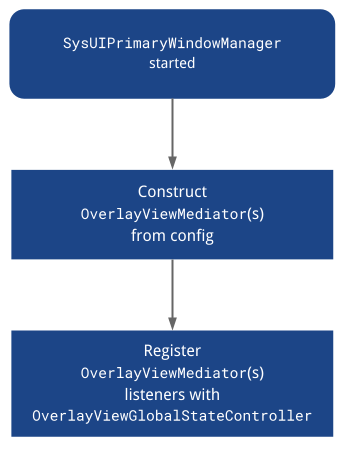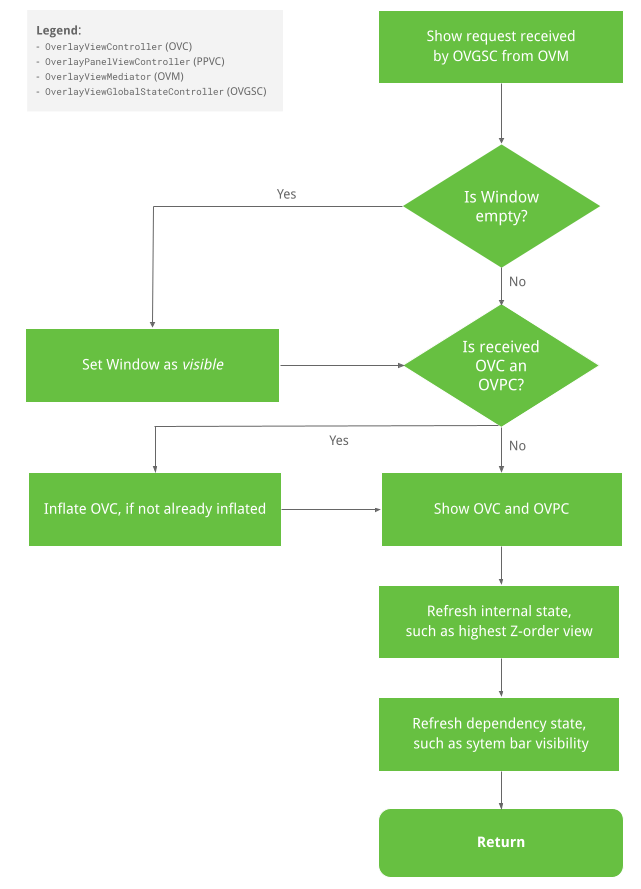Система управления SystemUIOverlayWindow предоставляет вам возможность отображать и управлять представлениями в SystemUIOverlayWindow . В настоящее время это окно используется для представлений, включая полноэкранный переключатель пользователей, панель уведомлений и защиту клавиатуры. На этой странице нет:
- Создайте ограничения на то, что OEM-производитель может добавить в окно.
- Заставить вас принять абстракции, описанные на этой странице.
Обзор
Вы можете использовать систему управления SystemUIOverlayWindow для отображения таких представлений, как юридическое уведомление, полноэкранный переключатель пользователей, камеру заднего вида, элементы управления HVAC и защиту клавиатуры. Это окно находится за пределами пространства приложения и дает вам контроль над Z-упорядочением представления, триггерами открытия/скрытия и общими настройками, включая размещение представления, размер, прозрачность и цвет. В то же время вам не нужно беспокоиться о состоянии системных панелей или других объектов системного пользовательского интерфейса, которые необходимо скрывать или показывать, когда их соответствующее представление скрыто или показано.
Чтобы воспользоваться преимуществами SystemUIOverlayWindow , вы создаете контроллеры представлений для посредников представлений. Медиаторы передаются глобальному контроллеру состояния окна. Эти посредники рассматривают:
- Координация между контроллерами представления.
- Собственная бизнес-логика для контроллеров представлений.
Контроллеры представления (координируемые посредниками представления):
- Имейте свою точку зрения.
- Создайте установщики, с помощью которых
OverlayViewsMediatorсможет присоединять бизнес-логику. - Создайте анимацию раскрытия и скрытия их вида.
SystemUIOverlayWindow Manager, компонент SystemUI, служит точкой входа для инициализации и регистрации медиаторов с помощью глобального контроллера состояния, в то время как глобальный контроллер состояния связан с контроллерами представлений таким образом, что посредники могут напрямую вызывать контроллеры представлений для отображения и скрытия представлений в окне.
Оверлейвиевконтроллер
OverlayViewController отвечает за представление, отображаемое в SystemUIOverlayWindow , и управляет раскрытием и скрытием представления. Он также позволяет подключать необходимые прослушиватели, чтобы их можно было привязать к бизнес-логике.
Важные сигнатуры методов
/**
* Owns a {@link View} that is present in SystemUIOverlayWindow.
*/
public class OverlayViewController {
/**
* Shows content of {@link OverlayViewController}.
*
* Should be used to show view externally and in particular by {@link OverlayViewMediator}.
*/
public final void start();
/**
* Hides content of {@link OverlayViewController}.
*
* Should be used to hide view externally and in particular by {@link OverlayViewMediator}.
*/
public final void stop();
/**
* Inflate layout owned by controller.
*/
public final void inflate(ViewGroup baseLayout);
/**
* Called once inflate finishes.
*/
protected void onFinishInflate();
/**
* Returns {@code true} if layout owned by controller has been inflated.
*/
public final boolean isInflated();
/**
* Subclasses should override this method to implement reveal animations and implement logic
* specific to when the layout owned by the controller is shown.
*
* Should only be overridden by Superclass but not called by any {@link OverlayViewMediator}.
*/
protected void showInternal();
/**
* Subclasses should override this method to implement conceal animations and implement logic
* specific to when the layout owned by the controller is hidden.
*
* Should only be overridden by Superclass but not called by any {@link OverlayViewMediator}.
*/
protected void hideInternal();
/**
* Provides access to layout owned by controller.
*/
protected final View getLayout();
/** Returns the {@link OverlayViewGlobalStateController}. */
protected final OverlayViewGlobalStateController getOverlayViewGlobalStateController();
/** Returns whether the view controlled by this controller is visible. */
public final boolean isVisible();
/**
* Returns the ID of the focus area that should receive focus when this view is the
* topmost view or {@link View#NO_ID} if there is no focus area.
*/
@IdRes
protected int getFocusAreaViewId();
/** Returns whether the view controlled by this controller has rotary focus. */
protected final boolean hasRotaryFocus();
/**
* Sets whether this view allows rotary focus. This should be set to {@code true} for the
* topmost layer in the overlay window and {@code false} for the others.
*/
public void setAllowRotaryFocus(boolean allowRotaryFocus);
/**
* Refreshes the rotary focus in this view if we are in rotary mode. If the view already has
* rotary focus, it leaves the focus alone. Returns {@code true} if a new view was focused.
*/
public boolean refreshRotaryFocusIfNeeded();
/**
* Returns {@code true} if heads up notifications should be displayed over this view.
*/
protected boolean shouldShowHUN();
/**
* Returns {@code true} if navigation bar insets should be displayed over this view. Has no
* effect if {@link #shouldFocusWindow} returns {@code false}.
*/
protected boolean shouldShowNavigationBarInsets();
/**
* Returns {@code true} if status bar insets should be displayed over this view. Has no
* effect if {@link #shouldFocusWindow} returns {@code false}.
*/
protected boolean shouldShowStatusBarInsets();
/**
* Returns {@code true} if this view should be hidden during the occluded state.
*/
protected boolean shouldShowWhenOccluded();
/**
* Returns {@code true} if the window should be focued when this view is visible. Note that
* returning {@code false} here means that {@link #shouldShowStatusBarInsets} and
* {@link #shouldShowNavigationBarInsets} will have no effect.
*/
protected boolean shouldFocusWindow();
/**
* Returns {@code true} if the window should use stable insets. Using stable insets means that
* even when system bars are temporarily not visible, inset from the system bars will still be
* applied.
*
* NOTE: When system bars are hidden in transient mode, insets from them will not be applied
* even when the system bars become visible. Setting the return value to {@true} here can
* prevent the OverlayView from overlapping with the system bars when that happens.
*/
protected boolean shouldUseStableInsets();
/**
* Returns the insets types to fit to the sysui overlay window when this
* {@link OverlayViewController} is in the foreground.
*/
@WindowInsets.Type.InsetsType
protected int getInsetTypesToFit();
/**
* Optionally returns the sides of enabled system bar insets to fit to the sysui overlay window
* when this {@link OverlayViewController} is in the foreground.
*
* For example, if the bottom and left system bars are enabled and this method returns
* WindowInsets.Side.LEFT, then the inset from the bottom system bar will be ignored.
*
* NOTE: By default, this method returns {@link #INVALID_INSET_SIDE}, so insets to fit are
* defined by {@link #getInsetTypesToFit()}, and not by this method, unless it is overridden
* by subclasses.
*
* NOTE: {@link #NO_INSET_SIDE} signifies no insets from any system bars will be honored. Each
* {@link OverlayViewController} can first take this value and add sides of the system bar
* insets to honor to it.
*
* NOTE: If getInsetSidesToFit is overridden to return {@link WindowInsets.Side}, it always
* takes precedence over {@link #getInsetTypesToFit()}. That is, the return value of {@link
* #getInsetTypesToFit()} will be ignored.
*/
@WindowInsets.Side.InsetsSide
protected int getInsetSidesToFit();
}ОверлейПанельВиевконтроллер
Контроллер OverlayPanelViewController расширяет OverlayViewController и предоставляет дополнительные возможности анимации перетаскивания для своего суперкласса.
Оверлейвиевмедиатор
OverlayViewMediator содержит бизнес-логику, которая показывает или скрывает несколько экземпляров OverlayViewController , поэтому в некотором смысле он также управляет координацией между контроллерами представлений.
/** * Controls when to show and hide {@link OverlayViewController}(s). */ public interface OverlayViewMediator { /** * Register listeners that could use ContentVisibilityAdjuster to show/hide content. * * Note that we do not unregister listeners because SystemUI components are expected to live * for the lifecycle of the device. */ void registerListeners(); /** * Allows for post-inflation callbacks and listeners to be set inside required {@link * OverlayViewController}(s). */ void setupOverlayContentViewControllers(); }
Системуиоверлайвиндовманажер
SystemUIOverlayWindowManager отвечает за роль объекта SystemUI, который служит точкой входа для системы управления SystemUIOverlayWindow для инициализации и регистрации экземпляров OverlayViewMediator с помощью OverlayViewGlobalStateController .

Оверлейвиевглобалстатеконтроллер
OverlayViewGlobalStateController получает вызовы от экземпляров OverlayViewController , чтобы раскрыть или скрыть себя. Следовательно, он также сохраняет состояние того, что отображается или скрыто в SystemUIOverlayWindow .
Порядок просмотра шоу показан ниже:

Скрыть поток просмотра
Порядок скрытия просмотра показан ниже:

Сигнатуры общедоступных методов
Сигнатуры открытых методов кодируются следующим образом:
/**
* This controller is responsible for the following:
* <p><ul>
* <li>Holds the global state for SystemUIOverlayWindow.
* <li>Allows {@link SystemUIOverlayWindowManager} to register {@link OverlayViewMediator}(s).
* <li>Enables {@link OverlayViewController)(s) to reveal/conceal themselves while respecting the
* global state of SystemUIOverlayWindow.
* </ul>
*/
@SysUISingleton
public class OverlayViewGlobalStateController {
/**
* Register {@link OverlayViewMediator} to use in SystemUIOverlayWindow.
*/
public void registerMediator(OverlayViewMediator overlayViewMediator);
/**
* Show content in Overlay Window using {@link OverlayPanelViewController}.
*
* This calls {@link OverlayViewGlobalStateController#showView(OverlayViewController, Runnable)}
* where the runnable is nullified since the actual showing of the panel is handled by the
* controller itself.
*/
public void showView(OverlayPanelViewController panelViewController);
/**
* Show content in Overlay Window using {@link OverlayViewController}.
*/
public void showView(OverlayViewController viewController, @Nullable Runnable show);
/**
* Hide content in Overlay Window using {@link OverlayPanelViewController}.
*
* This calls {@link OverlayViewGlobalStateController#hideView(OverlayViewController, Runnable)}
* where the runnable is nullified since the actual hiding of the panel is handled by the
* controller itself.
*/
public void hideView(OverlayPanelViewController panelViewController);
/**
* Hide content in Overlay Window using {@link OverlayViewController}.
*/
public void hideView(OverlayViewController viewController, @Nullable Runnable hide);
/** Returns {@code true} is the window is visible. */
public boolean isWindowVisible();
/**
* Sets the {@link android.view.WindowManager.LayoutParams#FLAG_ALT_FOCUSABLE_IM} flag of the
* sysui overlay window.
*/
public void setWindowNeedsInput(boolean needsInput);
/** Returns {@code true} if the window is focusable. */
public boolean isWindowFocusable();
/** Sets the focusable flag of the sysui overlawy window. */
public void setWindowFocusable(boolean focusable);
/** Inflates the view controlled by the given view controller. */
public void inflateView(OverlayViewController viewController);
/**
* Return {@code true} if OverlayWindow is in a state where HUNs should be displayed above it.
*/
public boolean shouldShowHUN();
/**
* Set the OverlayViewWindow to be in occluded or unoccluded state. When OverlayViewWindow is
* occluded, all views mounted to it that are not configured to be shown during occlusion will
* be hidden.
*/
public void setOccluded(boolean occluded);
}Как добавить представление в SysUIOverlayWindow
Подробности смотрите в Codelab .
Шаг 1. Добавьте ViewStub в SysUIOverlayWindow.
Добавьте ViewStub в макет окна .
Шаг 2. Создайте OverlayViewController
Используйте новый ViewStub для создания нового внедряемого OverlayViewController .
Шаг 3: Оверлейвиевмедиатор
Создайте новый внедряемый OverlayViewMediator или используйте существующий (пропустите шаг 4) и зарегистрируйте прослушиватели, чтобы скрыть или показать новый OverlayViewController .
Шаг 4. Настройте новый OverlayViewMediator.
Добавьте новый OverlayViewMediator в OverlayWindowModule и в config_carSystemUIOverlayViewsMediator .
Предостережения
Когда SysUIPrimaryWindow покрывает весь экран, любые элементы под окном не регистрируют события касания. Таким образом, когда окно занимает весь экран, но его содержимое оставляет некоторое свободное пространство, вы можете размыть это пространство и присоединить к этому пространству прослушиватели, чтобы закрыть содержимое окна.

